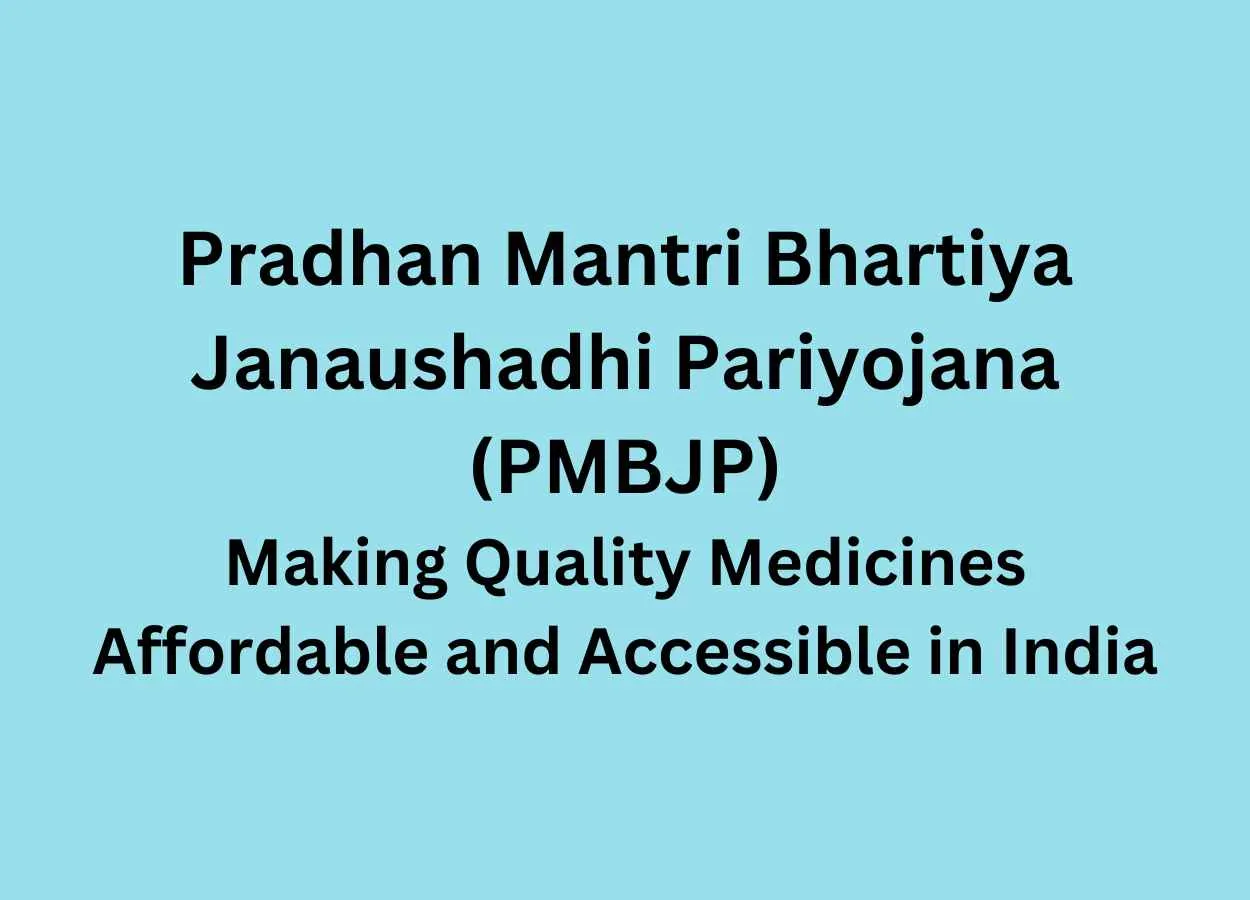About Author
Ramraj Choudhary M.Pharma, (Pharmaceutics)
Dr. H.S Gour University, Sagar MP
Current Position : Sr. Pharmacist, CGHS, MOHFW
Abstract
This article provides an overview of the Pradhan Mantri Bhartiya Janaushadhi Pariyojana (PMBJP) scheme in India. The PMBJP scheme aims to make quality generic medicines available and affordable to all sections of society, especially the economically weaker sections. The article discusses the types of medicines available through the scheme, quality standards, certification process, pricing, and benefits to the general public. The article also highlights the challenges faced by the PMBJP scheme in ensuring the availability and accessibility of medicines in remote areas. Furthermore, the article discusses the potential of PMBJP to expand and cover more medicines and medical devices, as well as its role in achieving the goal of universal health coverage in India. The article concludes by emphasizing the important role that pharmacists play in making the PMBJP and other similar schemes effective and important, including providing information, ensuring quality, promoting rational use of medicines, collaborating with healthcare providers, and monitoring adverse effects.
Reference Id: PHARMATUTOR-ART-3005
Introduction
PMBJP (Pradhan Mantri Bhartiya Janaushadhi Pariyojana) with an objective of making quality generic medicines available at affordable prices to all was launched by the Department of Pharmaceuticals, Ministry of Chemicals & Fertilizers, Government of India in November, 2008. Under the scheme, dedicated outlets known as Janaushadhi Kendras are opened to provide generic medicines at affordable prices. As on 31.10.2022, 8819 Janaushadhi Kendras are functional across the country. Target is to increase these kendras to 10500 by March 2025. Product basket of PMBJP comprises 1759 drugs and 280 surgical items. The Scheme is implemented by a society registered under the Societies Registration Act, viz., Pharma & Medical Bureau of India (PMBI) [erstwhile Bureau of Pharma PSUs of india (BPPI)] [1] [9] [10].
The main objective of PMBJP: - Is to make quality generic medicines available at affordable prices to all, especially the poor and disadvantaged sections of the society. The scheme aims to achieve this objective through the following :
• Ensure access to quality medicines for all sections of the population especially the poor and the deprived ones.
• Create awareness about generic medicines through education and publicity to counter the perception that quality is synonymous with high price only.
• Generate employment by engaging individual entrepreneurs in opening of PMBJP Kendra.
• Ensuring the quality of generic medicines sold under the scheme by sourcing them from WHO-GMP certified manufacturers. [1]
Affordable and quality medicines are of utmost importance in India due to the following reasons:
• Large population: - India is the second-most populous country in the world, with over 1.42 billion people. Many of them do not have access to quality healthcare facilities and cannot afford expensive medicines. Thus, making affordable and quality medicines available to them is crucial.
• High burden of disease: - India has a high burden of communicable and non-communicable diseases, and many of them require long-term medication. Affordable and quality medicines can help in treating these diseases effectively and reducing the morbidity and mortality rates.
• Rising healthcare costs: - The cost of healthcare in India has been rising steadily, and it has become a burden on many households, especially those from the lower socio-economic strata. Affordable medicines can help in reducing the out-of-pocket expenditure on healthcare.
• Increasing health awareness: - With increasing health awareness, people are becoming more conscious of their health and seeking quality healthcare services. Access to affordable and quality medicines can help in improving their health outcomes and quality of life.
Affordable and quality medicines are crucial for improving the health and well-being of the people in India, especially those from the lower socio-economic strata who cannot afford expensive healthcare services. [2]
Overview of PMBJP medicines
A. Types of medicines available through the PMBJP
Under the PMBJP, generic medicines are made available at Jan Aushadhi Kendras across the country. These medicines are sold at significantly lower prices than their branded counter parts. The types of medicines available through the PMBJP include:
• Allopathic medicines: These are traditional western medicines that are used to treat various diseases and conditions include:-
• Ayurvedic medicines: Ayurveda is a traditional system of medicine that originated in India. Ayurvedic medicines made from natural herbs and minerals are also available through the PMBJP.
• Surgical and consumables: The scheme also provides various surgical and consumable items like syringes, gloves, catheters, and surgical sutures at affordable prices.
It is important to note that the medicines available through the PMBJP are sourced from WHO-GMP certified manufacturers and are of good quality. Moreover, the scheme ensures that the medicines are sold only after due quality checks by authorized pharmacists. [3] [4]
B. The quality standards and certification process of PMBJP Medicines
The PMBJP ensures that the generic medicines sold at Jan Aushadhi Kendras meet the required quality standards. The medicines are sourced from WHO-GMP (World Health Organization - Good Manufacturing Practices) certified manufacturers and undergo various quality checks before they are sold to the public.
The quality standards and certification process of PMBJP medicines are as follows:
• WHO-GMP Certification: The PMBJP medicines are sourced only from manufacturers who have obtained the WHO-GMP certification. This certification ensures that the medicines are manufactured in accordance with the international quality standards set by the World Health Organization.
• Quality Control: The medicines undergo various quality control checks, including testing for their efficacy, safety, purity, and stability. Only medicines that pass these quality control checks are sold to the public.
• Approval by Drug Controller: The medicines are approved by the Drug Controller of India before they are sold at Jan Aushadhi Kendras. This ensures that the medicines meet the required quality standards and are safe for public consumption.
• Authorized Pharmacists: The medicines are sold only by authorized pharmacists who have undergone the required training and have the necessary qualifications to dispense medicines. This ensures that the medicines are sold in the right dose and under proper guidance.
• The PMBJP ensures that the generic medicines sold at Jan Aushadhi Kendras meet the required quality standards by sourcing them from WHO-GMP certified manufacturers, conducting quality control checks, obtaining approval from the Drug Controller of India, and selling them only through authorized pharmacists. [4]
C. The pricing of PMBJP medicines compared to branded medicines
The pricing of PMBJP medicines is significantly lower than that of branded medicines.
The PMBJP medicines are priced at an average of 50-90% lower than their branded counterparts. For example, a branded medicine that costs Rs. 100 per tablet may be available at a Jan Aushadhi Kendra for Rs. 10-20 per tablet. This significant difference in pricing makes the PMBJP medicines accessible to a larger population, especially those who cannot afford expensive branded medicines.
The lower pricing of PMBJP medicines is possible because they are generic medicines, which means that they do not carry any brand name and are sold under the generic name of the active ingredient. This eliminates the costs associated with brand promotion and marketing, resulting in lower prices for the end consumer.
Moreover, the PMBJP scheme also provides various incentives and subsidies to Jan Aushadhi Kendras to encourage them to sell medicines at affordable prices. This includes a 20% margin for retailers and a 10% margin for distributors, along with a reimbursement of up to Rs. 2.5 lakh for setting up a Jan Aushadhi Kendra.
The PMBJP medicines are priced significantly lower than their branded counterparts, making them accessible to a larger population, especially those from the lower socio-economic strata who cannot afford expensive healthcare services. [5] [7] [10]
Impact of PMBJP medicines:-
A. How PMBJP medicines have benefited the general public, especially the economically weaker sections of society? :-
The PMBJP has benefited the general public, especially the economically weaker sections of society, in the following ways:
• Affordable Medicines: The scheme provides quality generic medicines at significantly lower prices than their branded counterparts. This makes essential medicines affordable and accessible to a larger population, especially those from the lower socio-economic strata who cannot afford expensive healthcare services.
• Savings on Healthcare Costs: The availability of affordable medicines through the PMBJP has resulted in significant savings on healthcare costs for the general public. Patient’s no longer need to spend large amounts of money on expensive branded medicines and can instead avail of the same quality of treatment through affordable generic medicines.
• Improved Access to Medicines: The PMBJP has improved access to medicines for people living in remote and rural areas. Jan Aushadhi Kendras have been set up in areas where access to quality healthcare services is limited. This has helped in reducing the burden on public healthcare facilities and improving access to essential medicines in these areas.
• Better Health Outcomes: The availability of affordable medicines through the PMBJP has resulted in better health outcomes for the general public. Patients are able to afford essential medicines and are therefore able to manage their health conditions better. This has helped in reducing the burden on public healthcare facilities and improving the overall health of the population.
• Employment Generation: The PMBJP scheme has also generated employment opportunities for the local population. Jan Aushadhi Kendras are run by local entrepreneurs who are provided with financial support and training to set up and manage the Kendras. This has helped in generating employment opportunities and promoting entrepreneurship at the grassroots level.
The PMBJP scheme has benefited the general public, especially the economically weaker sections of society, by providing affordable medicines, improving access to essential medicines, reducing healthcare costs, improving health outcomes, and generating employment opportunities. [8]
B. Data on the increase in sales of PMBJP medicines and their market share:-
According to the official website of PMBJP, the sales of PMBJP medicines have seen a significant increase since the launch of the scheme. As of March 2021, the total sales turnover of PMBJP medicines was over Rs. 4,000 crores. The number of Jan Aushadhi Kendras has also increased from 80 in 2015 to over 7,000 in March 2021.
In the financial year 2021-22, sale of Rs. 893.56 Crore has been done, which has led to savings of about Rs. 5300 Crore to the citizens as compared to the branded medicines. In the current financial year i.e. 2022-23, PMBI has made sales of Rs. 758.69 Crore till 30.11.2022 which has led to savings of approximately Rs. 4500 Cr. to the citizens. Overall sales have seen a phenomenal growth which shows wider acceptance of Jan Aushadhi. [9] [10]
Overall, the sales of PMBJP medicines have seen a significant increase over the years, and their market share in the Indian pharmaceutical market has also increased steadily. The scheme has been successful in providing affordable and quality medicines to the general public, especially the economically weaker sections of society. [11]
C. How PMBJP medicines have helped in reducing healthcare costs for individuals and the government?-
The PMBJP scheme has helped in reducing healthcare costs for individuals and the government in the following ways:
• Affordable Medicines: The availability of quality generic medicines at significantly lower prices than their branded counterparts has helped in reducing healthcare costs for individuals. Patient’s no longer need to spend large amounts of money on expensive branded medicines and can instead avail of the same quality of treatment through affordable generic medicines. This has resulted in significant savings on healthcare costs for individuals.
• Reduced Dependence on Branded Medicines: The PMBJP scheme has helped in reducing the dependence on expensive branded medicines. This has helped in reducing the burden on the government to provide expensive branded medicines to the general public. The availability of affordable medicines through the PMBJP has also resulted in a reduction in the out-of-pocket expenses of individuals.
• Improved Access to Medicines: The PMBJP has improved access to medicines for people living in remote and rural areas. Jan Aushadhi Kendras have been set up in areas where access to quality healthcare services is limited. This has helped in reducing the burden on public healthcare facilities and improving access to essential medicines in these areas. Improved access to medicines has also resulted in a reduction in healthcare costs for individuals.
• Reduced Burden on Public Healthcare Facilities: The availability of affordable medicines through the PMBJP has reduced the burden on public healthcare facilities. Patients who can afford to buy medicines are no longer dependent on public healthcare facilities for free medicines. This has helped in reducing the burden on public healthcare facilities, which can then focus on providing healthcare services to those who cannot afford healthcare services.
The PMBJP scheme has helped in reducing healthcare costs for individuals and the government by providing affordable medicines, reducing dependence on expensive branded medicines, improving access to medicines, and reducing the burden on public healthcare facilities. This has resulted in significant savings on healthcare costs for individuals and the government. [10] [12]
Challenges and future prospects
A. The challenges faced by the PMBJP program in ensuring availability and accessibility of medicines in remote areas.-
The PMBJP (Pradhan Mantri Bhartiya Janaushadhi Pariyojana) program has faced several challenges in ensuring the availability and accessibility of medicines in remote areas. Some of the major challenges are:
• Logistics: The transportation of medicines to remote areas can be challenging due to poor road infrastructure, difficult terrain, and other logistical issues. This can result in delays in the supply of medicines to Jan Aushadhi Kendras in remote areas.
• Awareness: Lack of awareness about the PMBJP scheme among people living in remote areas can be a challenge. Many people living in remote areas may not be aware of the scheme or may not have access to information about the scheme.
• Infrastructure: Setting up Jan Aushadhi Kendras in remote areas can be challenging due to a lack of infrastructure. Remote areas may not have adequate facilities for setting up Kendras or may not have enough trained personnel to manage the Kendras.
• Supply Chain Management: Ensuring a steady supply of medicines to Jan Aushadhi Kendras in remote areas can be challenging due to the long supply chain involved. The supply chain involves multiple stakeholders, including manufacturers, distributors, and retailers, and any disruption in the supply chain can result in a shortage of medicines in remote areas.
• Regulatory Issues: Obtaining regulatory approvals for setting up Jan Aushadhi Kendras in remote areas can be a challenge. Regulatory approvals may be required from multiple agencies, and the process can be time-consuming and complex.
To address these challenges, the government has taken several initiatives such as providing financial incentives to Kendra owners, setting up regional warehouses, and providing training to Kendra owners and staff. The government has also launched a mobile app to help people locate their nearest Jan Aushadhi Kendra. Despite these efforts, ensuring the availability and accessibility of medicines in remote areas remains a challenge. [4]
B. The potential of PMBJP to expand and cover more medicines and medical devices
The PMBJP has the potential to expand and cover more medicines and medical devices in the future. The scheme has already made a significant impact on the availability and affordability of essential medicines, and the government is working to further strengthen and expand the program.
One of the key initiatives to expand the PMBJP scheme is the launch of Jan Aushadhi Suvidha Sanitary Napkin in 2019. This initiative aimed to provide affordable and high-quality sanitary napkins to women in rural and remote areas of the country.
Moreover, the government has also announced plans to include medical devices under the PMBJP scheme. This would allow patients to access high-quality medical devices at affordable prices. In addition, the government is also considering including surgical implants and stents under the scheme.
Furthermore, the government is also working on improving the distribution network of PMBJP stores by setting up more stores in remote areas and promoting online sales. This would ensure that essential medicines and medical devices are available to all, including those living in remote and rural areas.
Overall, the PMBJP scheme has immense potential to expand and cover more medicines and medical devices, thus benefiting a larger section of the population and contributing to the goal of universal health coverage in India. [13]
C. The role of PMBJP in achieving the goal of universal health coverage in India
The PMBJP has played a significant role in achieving the goal of universal health coverage in India. The scheme has helped in improving the availability and affordability of essential medicines, especially for the economically weaker sections of society. This has helped in reducing the financial burden of healthcare expenses on individuals and families.
The PMBJP scheme has been instrumental in increasing the availability of quality generic medicines in the country. It has also helped in reducing the prices of medicines, making them affordable for a larger section of the population. This has not only improved access to healthcare for individuals but has also helped in reducing the burden on the government healthcare system.
The PMBJP has played a significant role in achieving the goal of universal health coverage in India. The scheme has helped in improving the availability and affordability of essential medicines, especially for the economically weaker sections of society. This has helped in reducing the financial burden of healthcare expenses on individuals and families.
The PMBJP scheme has been instrumental in increasing the availability of quality generic medicines in the country. It has also helped in reducing the prices of medicines, making them affordable for a larger section of the population. This has not only improved access to healthcare for individuals but has also helped in reducing the burden on the government healthcare system. [14]
5. Pharmacist's contribution to make these schemes important and effective
Pharmacists play a crucial role in making the PMBJP and other similar schemes important and effective. They are the front-line healthcare professionals who dispense medicines to patients and provide valuable advice and guidance on their proper use.
Here are some ways pharmacists can contribute to making these schemes important and effective:
• Providing Information: Pharmacists can play a vital role in spreading awareness about the PMBJP and other similar schemes. They can educate their patients about the availability and benefits of affordable generic medicines and encourage them to use them.
• Ensuring Quality: Pharmacists have a responsibility to ensure the quality of medicines they dispense to their patients. They should ensure that the medicines they dispense are of good quality, meet the required standards, and are free from contamination.
• Promoting Rational Use of Medicines: Pharmacists can help in promoting the rational use of medicines by providing advice and guidance on their proper use. They can educate their patients on the importance of taking medicines as prescribed and the risks associated with self-medication.
• Collaborating with Healthcare Providers: Pharmacists can collaborate with other healthcare providers, such as doctors and nurses, to provide comprehensive care to their patients. They can work together to ensure that patients receive the right medicines at the right time and in the right dosage.
• Monitoring Adverse Effects: Pharmacists can monitor their patients for adverse effects of medicines and report them to the relevant authorities. This can help in identifying potential safety issues and taking corrective measures.
The Pharmacists play a crucial role in making the PMBJP and other similar schemes important and effective. Their contribution in ensuring the quality of medicines, promoting their rational use, and collaborating with other healthcare providers can help in achieving the goal of universal health coverage in India. [15]
Conclusion
In conclusion, the PMBJP scheme has been instrumental in making quality generic medicines available and affordable to all sections of society, especially the economically weaker sections in India. The scheme has been successful in increasing the accessibility of medicines to the masses and has helped in reducing healthcare costs for individuals and the government. However, there are still challenges that need to be addressed, such as ensuring the availability and accessibility of medicines in remote areas. The potential of the PMBJP to expand and cover more medicines and medical devices is promising, and it can play a crucial role in achieving the goal of universal health coverage in India. Pharmacists play a vital role in making the PMBJP and other similar schemes effective and important, and their contribution in ensuring the quality of medicines, promoting their rational use, and collaborating with other healthcare providers can help in achieving the goal of universal health coverage in India.
References:-
1. Ministry of chemicals and fertilizers, Department of pharmaceuticals, GOI, (2023) "Introduction to PMBJP (Pradhan Mantri Bhartiya Janaushadhi Pariyojan", available at, https://janaushadhi.gov.in/pmjy.aspx (accessed 30 April 2023).
2. Singh P, Ravi S, Dam D (2020), " Medicines in India: Accessibility, Affordability and Quality ", Brookings Institution India, Center No. 6, Second Floor, Dr Jose P Rizal Marg, Chanakyapuri, New Delhi – 110021.
3. Pharmaceuticals & Medical Devices Bureau of India (PMBI), Ministry of chemicals and fertilizers, Government of India, (2023), “PMBJP Products details”:, available at, http://janaushadhi.gov.in/SortingView.aspx (accessed 30 April 2023).
4. Lavtepatill S and Ghosh S (2022) “Improving access to medicines by popularising generics: a study of ‘India’s People’s Medicine’ scheme in two districts of Maharashtra”, BMC Health Services Research (2022).
5. Pharmaceuticals & Medical Devices Bureau of India (PMBI), Ministry of chemicals and fertilizers, Government of India, (2023) "Quality control and quality assurance to PMBJP Medicines", available at, https://cghs.nic.in/PMBI-Quality_Products_brochure.pdf (accessed 30 April 2023).
6.”Gap in Price of Branded and Janaushadhi Medicine”, Posted On: 11 FEB 2022 7:46PM by PIB, available at, https://pib.gov.in/PressReleaseIframePage.aspx?PRID=1797762.
7. Mukherjee K (2017), “A Cost Analysis of the Jan Aushadhi Scheme in India”, Int J Health Policy Manag.
8. Joshil D, Gupta S, Singh T.G, Prashar A, Gauniyal S and Singh S.K (2022), “A study of various existing interventions for the treatment of hypertension in the Indian market under the Jan Aushadhi Scheme”, Health Policy & Outcomes Research, Chitkara College of Pharmacy, Chitkara University, Rajpura India, KLE College of Pharmacy, Hubballi, Karnataka, India, School of Pharmaceutical Sciences, Lovely Professional University, Phagwara, India.
9. “Government has deepened the reach of PMBJP with more than 9000 stores covering 743 out of 766 districts across the country”, Posted On. DEC 2022 2:29PM by PIB Delhi.
10. “Year End Review of Department of Pharmaceuticals-2022”, Posted On: 22 DEC 2022 4:10PM by PIB Delhi.
11. Viswanath P, (2023) , The economic times, “Centre steps to push affordable generic drugs help Jan Aushadhi stores cross sales target”, Daily News, Apr 08, 2023, available at, https://economictimes.indiatimes.com/industry/healthcare/biotech/pharmaceuticals/centre-steps-to-push-affordable-generic-drugs-help-jan-aushadhi-stores-cross-sales-target/articleshow/99325968.cms?utm_source=contentofinterest&utm_medium=text&utm_campaign=cppst
12. Srinivasan P (2023), “Impact of Bureau of Pharma PSU’s India Affordable Cost Medicine Scheme on Economic Consumers”, Department of Allergy and Infectious Diseases, National Institutes of Health, Rockville, USA.
13. The economic times (2021), “Government aims to increase Janaushadhi Kendras to 10,000 by 2024” Daily News , Oct 12, 2021, available at, https://economictimes.indiatimes.com/news/india/government-aims-to-increase-janaushadhi-kendras-to-10000-by-2024/articleshow/86967607.cms?utm_source=contentofinterest&utm_medium=text&utm_campaign=cppst
14. Medknow W.K (2020), “Achieving Universal Health Coverage in India: The Need for Multisectoral Public Health Action”, Indian Journal of Community Medicine.
15. Pharmaceuticals & Medical Devices Bureau of India (PMBI), Ministry of chemicals and fertilizers, Government of India, (2022), “Guidelines for Opening of New Pradhan Mantri Bhartiya Janaushadhi Kendra (PMBJK) For Unemployed pharmacists, Individual entrepreneurs, Doctors, Registered medical practitioners, Available at,
http://janaushadhi.gov.in/pdf/Individuals_PMBJP.pdf (accessed 30 April 2023).









